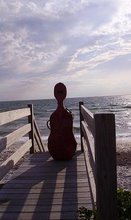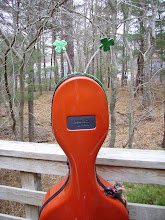
View of Boston from The Hollow.
Yesterday’s clam bake/lobster meal was great! What a delight! We ate outside, in an area called The Hollow, where the chairs can be arranged for performances or for eating. There was some entertainment beforehand. Our fiddle teachers played “French Folk Song” slowly and out of tune before launching into another exquisite set of Scottish tunes. There was also an auction items and services donated by campers to raise money for a former camp instructor who is being treated for cancer.
There was a dance afterwards, but I returned to my room with the idea that I would practice. I didn’t though. I went to bed early. It had been a busy tune-filled day.
Anne returned to teaching Beginning Fiddle, and we continued working on “High Road to Linton,” which has four parts. We reviewed the first part and learned two more parts. I missed Hanneke’s “close-your-eyes-and-listen” approach, but for one of the parts and analytical approach worked better. There were repeating four-note sections, in which the first part of each section was the first note of a turn (C-D-C-B).
In Cello class, I have been sitting at the edge of the class, where a view of Abby’s hand is often unclear. Thursday, I had a clear front-and-center view and had no problem starting of the tune because I could clearly see which notes she was playing. (The woman who took my end seat, who usually has no problem getting the tunes said what I had earlier: “I don’t even know what note you’re starting on.”) When things got complicated, it actually helped to look away though and just focus on the listening. The new tune, a jig, moves around from first to second to third and fourth positions and features a Shetland bowing. Watching was confusing though because I always fell behind trying to analyze what Abby was doing. So, I was torn between taking advantage of my great position visually and ignoring that position to focus on the tune.
One of the cellists who had been in Hanneke’s class with me said it was helpful to keep a free brain: to focus on the listening and the music and rid yourself of other thoughts, especially those “I can’t possibly do this” thoughts.
Another of the cellists who usually gets all the tunes said the standard session tunes were easier to learn than Abby’s more unusual music. We all agreed we loved Abby’s selection of music though.
After class I was torn between practicing, taking a nap, or going for a walk. I went for a walk, to the end of the island. I picked the closest end, the one heading in the direction of Scotland, and enjoyed a peaceful journey along a path through woods and meadows, with views of the ocean and Boston’s Logan International Airport.
It is hard to play in class for three or four hours and then find time and energy to practice. Still, I like the schedule here. There is a half hour between classes in the morning, an hour and a half break for lunch, and classes are over by 3:30. Dinner is from 6 to 7, and the evening’s entertainments start at 8 pm. There is always an opportunity to play at sessions or with other people.
Tonight there is another big party, the Ceilidh, preceded and followed by sessions. The Ceilidh include performances, skits, amusements, and dancing. It will be hard to leave this little island in the morning, but it will be nice to have time to practice some of these tunes (and all that other music I should be working on but have been neglecting).
This is my dorm building. My room is the basement room on the left end of the building. My cello class meets under the trees (where the cellos are), and my wi-fi center is the table. Pretty easy commute.
This is the side view of my dorm building. My side window is the one in front, on the right. Behind the building, you can see the soccer field. At the end of the soccer field is a path to the end of the island that I followed yesterday.
Logan airport from the walking path. (This is where I was when I called you, Glenn!)















No comments:
Post a Comment